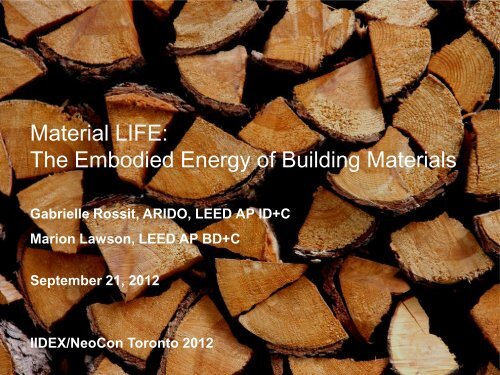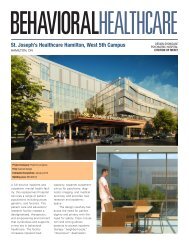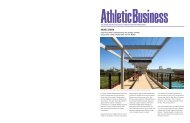material life - Cannon Design
material life - Cannon Design
material life - Cannon Design
Create successful ePaper yourself
Turn your PDF publications into a flip-book with our unique Google optimized e-Paper software.
Material LIFE:<br />
The Embodied Energy of Building Materials<br />
Gabrielle Rossit, ARIDO, LEED AP ID+C<br />
Marion Lawson, LEED AP BD+C<br />
September 21, 2012<br />
IIDEX/NeoCon Toronto 2012
Learning Objectives for Today’s Session<br />
1. Explain how to define a building <strong>material</strong>’s embodied energy content.<br />
2. Describe the findings of an examination of the current research and existing datasets<br />
and tools related to embodied energy from among product manufacturers, peer<br />
design firms and academic or non‐profit institutions.<br />
3. Describe customized tools that are available to project teams for using embodied<br />
energy as a selection criterion in <strong>material</strong> specifications.<br />
4. Using two current design projects as examples, explain how <strong>material</strong> embodied<br />
energy research has been applied.
SECTION 1<br />
Why Embodied Energy?<br />
SECTION 5<br />
Material LIFE<br />
SECTION 2<br />
Defining Embodied Energy<br />
SECTION 6<br />
Case Study: <strong>Cannon</strong> <strong>Design</strong> Chicago Office<br />
SECTION 3<br />
Our Research Process & Findings<br />
SECTION 7<br />
Case Study: <strong>Cannon</strong> <strong>Design</strong> Washington D.C. Office<br />
SECTION 4<br />
Mbod-E Calculator<br />
SECTION 8<br />
Conclusions
1. Why Embodied Energy?<br />
<strong>Cannon</strong> <strong>Design</strong> Chicago Office<br />
<strong>Cannon</strong> <strong>Design</strong>
1. Why Embodied Energy?<br />
- Energy is embodied in everything we use and depend on; it includes:<br />
• Extraction of raw <strong>material</strong>s<br />
• Transportation of <strong>material</strong>s<br />
• Manufacture/processing of <strong>material</strong>s, food, clothing, etc.<br />
• Usage and disposal/recycling<br />
- Greenhouse gas emissions of manufacturing processes<br />
- Often ignored because not as ―visible‖ or easy to track as operational energy
1. Why Embodied Energy?<br />
U.S. energy consumption by sector<br />
Source: Architecture 2030 and Richard Stein 1977
1. Why Embodied Energy?<br />
At beginning of building <strong>life</strong>, embodied energy = 100% of building’s energy<br />
~<br />
~<br />
~<br />
~<br />
Source: Architecture 2030, 2030 Inc.
1. Why Embodied Energy?<br />
At end of <strong>life</strong>-cycle (year 50), operational energy = 75% and embodied energy = 25%<br />
~<br />
~<br />
~<br />
~<br />
Source: Architecture 2030, 2030 Inc.
1. Why Embodied Energy?<br />
Embodied Energy = Operational Energy around year 15-20<br />
~<br />
~<br />
~<br />
2027<br />
~<br />
Source: Architecture 2030, 2030 Inc.
1. Why Embodied Energy?<br />
Embodied energy<br />
Embodied energy of capital improvements<br />
Operational energy<br />
Reduced operational energy<br />
YR 0 YR 15-20 YR 25-30 YR 50<br />
As operational energy is reduced, the impact of embodied energy increases.
1. Why Embodied Energy?<br />
Architecture industry’s interest in embodied energy:<br />
- Understand how building <strong>material</strong>s are manufactured<br />
- Specify sustainable products<br />
- Consider entire <strong>life</strong>-cycle of products<br />
- Encourage manufacturers to find more efficient processes<br />
- Commitment to reduce carbon footprint of buildings
2. Defining Embodied Energy<br />
- Embodied energy = the sum of energy inputs to make a product<br />
- For full cradle-to-grave cycle, energy inputs from:<br />
• Extraction of raw <strong>material</strong>s<br />
• Transportation to factory<br />
• Manufacture of product / components<br />
• Assembly of product / system<br />
• Transportation to site / point of sale<br />
• Installation / construction<br />
• Maintenance<br />
• Replacement<br />
• Disposal / re-purposing / recycling
2. Defining Embodied Energy<br />
- Embodied energy for building <strong>material</strong>s is often measured cradle-to-gate (extraction,<br />
transportation, manufacture, packaging)
2. Defining Embodied Energy<br />
WASTE ENERGY SITE ENERGY<br />
Fossil Fuel<br />
Non-fossil Fuel<br />
Embodied<br />
Carbon<br />
Embodied<br />
Energy<br />
Energy to manufacture product<br />
Product or<br />
Building<br />
Impact
2. Defining Embodied Energy<br />
Typical office building:<br />
- 50% of embodied energy from envelope and structure<br />
- Average = 4.82 GJ/m 2 or 447.8 MJ/ft 2<br />
- 1 MJ = 0.948 kBtu<br />
Breakdown of initial embodied energy for typical office building<br />
Source: Cole and Kernan, 1996
3. Research Process & Findings<br />
Multi-disciplinary research team<br />
Goals:<br />
• Calculate and evaluate embodied energy of building <strong>material</strong>s<br />
• Develop embodied energy calculator specific to building industry<br />
• Develop design tools to help with <strong>material</strong> selection<br />
• Adopt a comprehensive and sustainable approach to <strong>material</strong> selection
3. Research Process & Findings<br />
Literature review:<br />
- Subject gained interest 20-30 years ago<br />
- Majority of research comes from U.K.<br />
and Australia<br />
- Most comprehensive research from<br />
Hammond and Jones at University of<br />
Bath<br />
- Data pulled from Life Cycle Assessments<br />
- No rating / certification system currently<br />
exists for embodied energy
3. Research Process & Findings<br />
USGBC LEED rating system indirectly addresses embodied energy:<br />
• Regional <strong>material</strong>s<br />
• Recycled content<br />
• Material / building reuse
3. Research Process & Findings<br />
Study of existing calculators/databases:<br />
- University of Bath Inventory of Carbon and Energy (ICE)<br />
- Athena Institute Eco Calculator<br />
- GRANTA CES Selector software – Eco Audit Tool<br />
- GaBi software<br />
- BEES software<br />
University of Bath ICE<br />
embodied energy database for <strong>material</strong>s
3. Research Process & Findings<br />
Interviews/discussions with industry peers<br />
Kieran Timberlake<br />
• Embodied energy research<br />
• Used on several projects<br />
Architecture 2030<br />
• 2030 Challenge for Products<br />
USG<br />
• Life-Cycle Assessments (LCAs)<br />
Herman Miller<br />
• Life-Cycle Assessments (LCAs)<br />
Thornton Tomasetti<br />
• Signed on to 2030 Commitment<br />
• Embodied energy research for<br />
structural systems
3. Research Process & Findings<br />
Comparable research<br />
Cellophane House, MOMA<br />
New York, NY<br />
Kieran Timberlake<br />
The David & Lucile Packard<br />
Foundation, Los Altos, CA<br />
EHDD Architecture<br />
Portola Valley Town Center,<br />
Portola Valley, CA<br />
Siegel & Strain Architects
3. Research Process & Findings<br />
Life-Cycle Assessment (LCA) and<br />
Environmental Product Declaration (EPD)<br />
- Governed by ISO standards<br />
- Cradle-to grave analysis of products/<strong>material</strong>s<br />
- Include embodied energy as well as other<br />
environmental factors<br />
- Drive product comparison within industry
3. Research Process & Findings<br />
Research initial findings:<br />
- Subject of embodied energy and carbon is gaining attention in the industry<br />
- Focus seems to be more on embodied carbon rather than energy (Architecture 2030)<br />
- Some industry leaders have committed to conducting EPDs for all products<br />
- More manufacturers and product reps need to understand embodied energy<br />
- To our knowledge, no one has developed an industry-specific calculator
3. Research Process & Findings<br />
Research result:<br />
We need a calculator to track embodied energy in buildings.<br />
We need an embodied energy tool to provide design guidance.
4. Mbod-E Calculator<br />
- Goal of calculator: calculate embodied energy of building <strong>material</strong>s, assemblies,<br />
and entire projects<br />
- Resources used:<br />
• ICE database<br />
• Product-specific LCAs from manufacturers<br />
• Product-specific EPDs from manufacturers<br />
• Information acquired from manufacturers (when available)<br />
- Current format: Excel calculator
4. Mbod-E Calculator<br />
Organized according to ASTM UNIFORMAT II categories:<br />
- A10 & A20 – Foundations & Basement Construction<br />
- B10 – Superstructure<br />
- B20 – Exterior Closure<br />
- B30 – Roofing<br />
- C10 – Interior Construction<br />
• C1010 – Partitions<br />
• C1020 – Doors<br />
• C1030 – Fittings<br />
- C20 – Staircases<br />
- C30 – Interior Finishes<br />
• C3010 – Wall<br />
• C3020 – Floor<br />
• C3030 – Ceiling<br />
- E20 – Furnishings<br />
• E2010 – Fixed<br />
• E2020 - Movable
4. Mbod-E Calculator<br />
- Categories not currently included:<br />
• D10 – Conveying<br />
• D20 – Plumbing<br />
• D30 – HVAC<br />
• D40 – Fire Protection<br />
• D50 – Electrical<br />
• E10 – Equipment<br />
- Not included due to difficulty of<br />
assembly calculations<br />
- Best way to get values:<br />
directly from manufacturers
4. Mbod-E Calculator<br />
Inputs for calculator = <strong>material</strong> quantities<br />
- Finishes: typically in ft 2<br />
- Partitions: ft 2 of wall (calculator accounts for thickness)<br />
- Furnishings: # of units<br />
- Lumber & steel studs: linear feet
4. Mbod-E Calculator<br />
BIM warehouses and Mbod-E<br />
- Completed warehouses: partitions, doors<br />
- Future work: window warehouse, finish tags, etc.
4. Mbod-E Calculator<br />
BIM schedules and Mbod-E<br />
- Embodied energy built into wall property = efficient system<br />
- Automated calculation<br />
- Unit values and total values appear in schedules<br />
- Creating project baselines for firm
5. Material LIFE
5. Material LIFE<br />
<strong>Design</strong> tool rather than calculator<br />
Quick <strong>material</strong> comparisons<br />
Used for <strong>material</strong> selection<br />
Same UNIFORMAT II categories<br />
as Mbod-E calculator<br />
Detailed comparisons for specific<br />
<strong>material</strong>s (i.e. carpet types)
5. Material LIFE<br />
Summary page<br />
- For each UNIFORMAT group<br />
- Shows range of each <strong>material</strong><br />
- Highlights mean of <strong>material</strong><br />
- Materials grouped by type<br />
- Example: wall finishes<br />
• Tackable<br />
• Directly applied to wall<br />
• Applied to wall with adhesive<br />
or cement<br />
• Mechanically attached to<br />
wall or frame
5. Material LIFE<br />
Values page<br />
- Detailed range for specific<br />
product within <strong>material</strong> group<br />
- Examples:<br />
• Different thickness<br />
• Primary vs. recycled<br />
• Solid vs. veneer panels
5. Material LIFE<br />
Material page<br />
- Graphs specific characteristics<br />
- Examples:<br />
• Material type (i.e. metals:<br />
aluminum, steel)<br />
• Primary vs. recycled
5. Material LIFE
5. Material LIFE<br />
Carpet detail page<br />
- Different carpet types (Nylon 6 vs. Nylon 6,6)<br />
- Modular vs. Broadloom<br />
- Backing options
6. Case Study: <strong>Cannon</strong> <strong>Design</strong> Chicago Office<br />
<strong>Cannon</strong> <strong>Design</strong> Chicago Office, Chicago, IL
6. Case Study: <strong>Cannon</strong> <strong>Design</strong> Chicago Office<br />
<strong>Cannon</strong> <strong>Design</strong> Chicago Office, Chicago, IL
6. Case Study: <strong>Cannon</strong> <strong>Design</strong> Chicago Office<br />
Project:<br />
- Relocation of <strong>Cannon</strong> <strong>Design</strong><br />
office in Chicago<br />
- 60,205 sf floor in office tower<br />
Sustainability goals:<br />
- LEED-CI Platinum<br />
- Reuse <strong>material</strong>s and furniture<br />
whenever possible<br />
- Reduce embodied energy of<br />
project overall<br />
- Pilot project of embodied<br />
energy tools
6. Case Study: <strong>Cannon</strong> <strong>Design</strong> Chicago Office<br />
Collaboration with research team:<br />
- Provided feedback on calculator<br />
- Addressed ease of use<br />
- Advice led to creation of Material LIFE<br />
- Provided preliminary <strong>material</strong><br />
selection lists for embodied energy<br />
comparisons:<br />
• Carpet<br />
• Write-on wall finishes<br />
• Furniture
6. Case Study: <strong>Cannon</strong> <strong>Design</strong> Chicago Office<br />
MANUFACTURER<br />
CARPET<br />
TYPE<br />
PRODUCT YARN TYPE DYE METHOD BACKING<br />
PILE<br />
WEIGHT<br />
EMBODIED<br />
ENERGY<br />
Bentley Prince Street Broadloom Satellite City Tile Nylon 6,6 100% solution dye High PerformancePC 24 oz/yd 2 16.639 MJ/ft 2<br />
FLOR Modular Shear Indulgence 100% British Wool undyed GlasBac Tile 43 oz/yd 2 unknown<br />
InterfaceFLOR Modular Raw Nylon 6 100% solution dye GlasBacRE Tile 24 oz/yd 2 9.199 MJ/ft 2<br />
InterfaceFLOR Modular Distressed Nylon 6 unknown (assume solution) GlasBac Tile 16 oz/yd 2 11.636 MJ/ft 2<br />
Mannington Modular Spatial Progressions Nylon 6,6 100% solution dye Infinity RE Modular 24 oz/yd 2 unknown<br />
Shaw Contract Group Modular Ambient Tile Nylon 6 72% solution, 28% piece ecoworx tile 24 oz/yd 2 28.196 MJ/ft 2<br />
MANUFACTURER<br />
EMBODIED<br />
ENERGY<br />
Bentley Prince Street 16.639 MJ/ft 2<br />
FLOR<br />
unknown<br />
InterfaceFLOR 9.199 MJ/ft 2<br />
InterfaceFLOR 11.636 MJ/ft 2<br />
Mannington<br />
unknown<br />
Shaw Contract Group 28.196 MJ/ft 2
6. Case Study: <strong>Cannon</strong> <strong>Design</strong> Chicago Office<br />
Furniture selection:<br />
- RFP language sent to furniture<br />
manufacturers<br />
- Proposals passed to research team<br />
for evaluation<br />
As part of <strong>Cannon</strong> <strong>Design</strong>’s office relocation, we are<br />
conducting research on the embodied energy of the<br />
products we are using in the design of the space. This<br />
information will inform design decisions we will make on<br />
this project. For each product, please provide the<br />
following information:<br />
• Product Name<br />
• Locations of manufacture and final assembly<br />
• Life Cycle Assessment report for the product, which<br />
includes cradle-to-gate embodied energy assessment<br />
• Complete list of all component <strong>material</strong>s and their<br />
respective weights
6. Case Study: <strong>Cannon</strong> <strong>Design</strong> Chicago Office<br />
LCA data for work stations from Herman Miller<br />
System Boundaries<br />
Lifecycle Stage<br />
Inputs from<br />
Environment<br />
Raw Material<br />
Extraction/Production<br />
Raw Material<br />
Extraction and<br />
Processing<br />
Transport<br />
Part Production at<br />
outside suppliers<br />
Transport<br />
Part Production at<br />
Herman Miller<br />
Production<br />
Assembly At Herman<br />
Miller<br />
Distribution to<br />
Customer<br />
Emissions to<br />
Environment<br />
Distribution<br />
Use<br />
Use<br />
Disassembly<br />
Transport<br />
End of Life<br />
Disposal<br />
Recycling
6. Case Study: <strong>Cannon</strong> <strong>Design</strong> Chicago Office<br />
LCA data for work stations from Herman Miller<br />
Water Emissions<br />
LCI Results Unit Total<br />
Raw Material<br />
Production<br />
Product<br />
Production<br />
Distribution and<br />
Retail<br />
End of Life<br />
Phosphates kg 2.6x10 -4 2.6x10 -4 4.0x10 -6 1.1x10 -7 5.2x10 -7<br />
Nitrates kg 2.1x10 -3 0.0x10 0 2.1x10 -3 4.0x10 -7 7.8x10 -6<br />
Dioxin kg 1.4x10 -15 1.4x10 -15 2.9x10 -19 3.3x10 -22 3.5x10 -22<br />
Heavy Metals kg 3.4x10 -2 2.2x10 -2 1.1x10 -2 1.3x10 -5 2.1x10 -4<br />
Air Emissions<br />
Nitrogen Oxides (NO x ) kg 5.1x10 -1 2.4x10 -1 2.7x10 -1 4.9x10 -4 4.1x10 -3<br />
Sulfur Oxides (SO x ) kg 7.3x10 -1 3.8x10 -1 3.5x10 -1 3.5x10 -4 1.9x10 -3<br />
Carbon Dioxide (CO 2 ) kg 2.8x10 2 1.5x10 2 1.3x10 2 7.6x10 -1 1.3x10 0<br />
Methane (CH 4 ) kg 4.9x10 -1 3.1x10 -1 1.8x10 -1 9.0x10 -4 1.6x10 -3<br />
Nitrous Oxide (Laughing Gas, N 2 O) kg 6.0x10 -3 4.3x10 -3 1.6x10 -3 3.3x10 -6 8.4x10 -6<br />
NMVOCs kg 8.9x10 -2 6.8x10 -2 2.0x10 -2 3.2x10 -4 1.1x10 -3<br />
Energy Demand<br />
Primary Energy MJ 4.0x10 3 2.1x10 3 2.0x10 3 1.1x10 1 1.9x10 1<br />
Fossil Fuel Energy MJ 3.5x10 3 1.8x10 3 1.7x10 3 1.1x10 1 1.9x10 1<br />
Nuclear Energy MJ 5.3x10 2 3.0x10 2 2.3x10 2 5.8x10 -2 3.8x10 -1<br />
Renewable Energy MJ 0.0x10 0 0.0x10 0 0.0x10 0 0.0x10 0 0.0x10 0<br />
Waste<br />
Waste to Landfill kg 5.1x10 1 0.0x10 0 0.0x10 0 0.0x10 0 5.1x10 1<br />
Waste to Incinerator kg 0.0x10 0 0.0x10 0 0.0x10 0 0.0x10 0 0.0x10 0<br />
Waste to Recycling kg 1.7x10 1 0.0x10 0 6.9x10 0 0.0x10 0 9.6x10 0<br />
Hazardous Waste kg 1.8x10 -1 1.8x10 -1 0.0x10 0 0.0x10 0 0.0x10 0<br />
Other<br />
Consumptive Water Use kg 1.8x10 3 1.3x10 3 5.9x10 2 2.7x10 -1 1.4x10 1
6. Case Study: <strong>Cannon</strong> <strong>Design</strong> Chicago Office
6. Case Study: <strong>Cannon</strong> <strong>Design</strong> Chicago Office<br />
85.6 MJ/ft 2<br />
(921.4 MJ/m 2 )<br />
81.1 kBtu/ft 2<br />
(255.8 kWh/m 2 )
6. Case Study: <strong>Cannon</strong> <strong>Design</strong> Chicago Office<br />
Embodied energy and operation energy:<br />
- Embodied energy = 85.6 MJ/ft 2 = 81.1 kBtu/ft 2 (255.8 kWh/m 2 )<br />
- Operational energy = 548,580 kWh/year = 31.1 kBtu/ft 2 /yr (98.1 kWh/m 2 /yr)<br />
- Note: embodied does not include MEP<br />
Embodied = Operational<br />
YR 2.6<br />
Move-in day YR 1 YR 2 YR 3 YR 4
7. Case Study: <strong>Cannon</strong> <strong>Design</strong> Washington D.C. Office
7. Case Study: <strong>Cannon</strong> <strong>Design</strong> Washington D.C. Office
7. Case Study: <strong>Cannon</strong> <strong>Design</strong> Washington D.C. Office
7. Case Study: <strong>Cannon</strong> <strong>Design</strong> Washington D.C. Office<br />
- Similar approach to Chicago<br />
Office project<br />
- Reused almost all furniture<br />
- Received embodied energy<br />
data from Teknion
7. Case Study: <strong>Cannon</strong> <strong>Design</strong> Washington D.C. Office<br />
42.3 MJ/ft 2<br />
(455.3 MJ/m 2 )<br />
40.1 kBtu/ft 2<br />
(126.5 kWh/m 2 )
7. Case Study: <strong>Cannon</strong> <strong>Design</strong> Washington D.C. Office<br />
Chicago Office<br />
41.5 MJ/ft 2 (446.7 MJ/m 2 )<br />
Washington D.C. Office<br />
34.4 MJ/ft 2 (370.3 MJ/m 2 )
8. Conclusions<br />
Building <strong>life</strong>-cycle does matter<br />
Consider the balance between embodied energy and operational energy<br />
The building industry is learning and you can help engage all sectors
8. Conclusions<br />
How can designers contribute?<br />
- Ask manufacturers & product reps for LCAs and EPDs<br />
- Talk about embodied energy so product reps know that the industry cares about it<br />
- Sign on to the Architecture 2030 Challenge for Products<br />
How can manufacturers contribute?<br />
- Increase product transparency around embodied energy — very soon it will matter<br />
to your bottom line<br />
- Drive waste from the manufacturing process and innovate new technologies
EXPLORATION
Thank You<br />
FOR A COPY OF MATERIAL LIFE ON CANNON DESIGN WEBSITE:<br />
http://media.cannondesign.com/uploads/files/MaterialLife-9-6.pdf<br />
FOR MORE INFORMATION PLEASE CONTACT:<br />
Gabrielle Rossit<br />
416.915.0121 (Toronto)<br />
grossit@cannondesign.com<br />
Marion Lawson<br />
312.960.8382 (Chicago)<br />
mlawson@cannondesign.com




